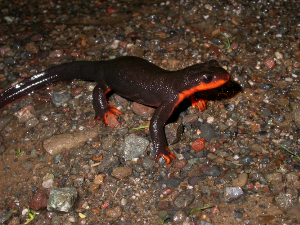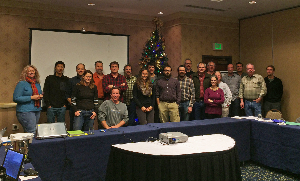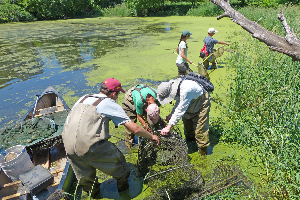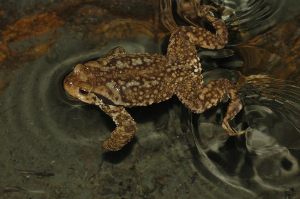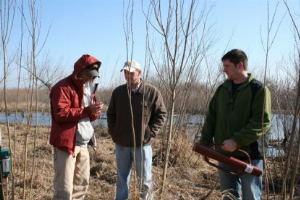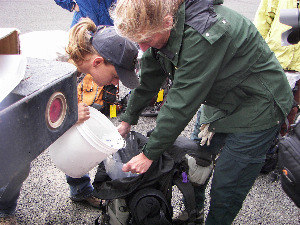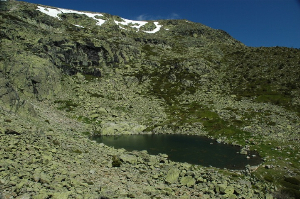Search ARMI Database
Search term(s)
Contribution Number
Search Results
180 record(s) found.
News & Stories Salamander chytrid fungus working group; June 2015
The salamander chytrid fungus (Batrachochytrium salamandrivorans; Bsal) was described in 2014, when die-offs in fire salamander (Salamandra salamandra) populations were reported in Europe. Susceptibility to this pathogen varies, but lethality is indicated in the families Salamandridae and Plethodontidae and members of both families occur in the US. Based on this endemicity, the discontinuity of the global incidence of Bsal, and the popularity of salamanders as pets, the emergence of this pathogen in Europe is presumed to have originated via the pet trade.
Over 28 million amphibians were imported in the US over a 6 year period during the last decade and that importation rate has not declined. Thus, there is serious concern that the disease may be introduced into the US in the near future, if it is not already present. This is particularly alarming because the eastern US is home to the highest diversity of salamanders in the world, including 141 species in the known susceptible family, Plethodontidae. Bsal is also known to be lethal to other US genera in the family Salamandridae (the rough skinned newt, Taricha granulosa, in the Pacific Northwest, and the Eastern newt Notophthalmus viridescens). This pathogen has the potential to have devastating consequences for native US salamanders, similar to extirpations observed in frog species in South America and Australia.
Therefore, a primary objective is to design a sampling strategy to detect the occurrence of the disease in the US (i.e., surveillance). Regardless of whether the disease already occurs in the US, a monitoring design must be developed to identify, with sufficient power, the probability the disease occurs in amphibian populations throughout the US, which must be assessed annually along with population estimates to understand the spread of Bsal and the fate of infected populations. A monitoring program in absence of a management plan is of limited use, and the design of a surveillance and monitoring program must consider possible management responses to monitoring results.
The threat of Bsal to US species provides a unique opportunity to address the introduction, spread, population effects, and control strategies for a novel infectious disease before we are dealing with widespread declines in native populations. By framing this crisis as an opportunity for learning and approaching the problem in a formal decision making context, we will increase the probabilities of early detection, containment, and successful mitigation of the Bsal pathogen. This working group will also provide a template for planning actions for future novel infectious diseases.
There is no coordinated effort to bring together scientists, managers, and policy makers to confront this crisis. In fact, such an approach to emerging infectious diseases is unprecedented, though this conceptual approach has been suggested in other disease outbreak contexts. We propose to bring together scientists, managers, and policy makers to develop an optimal surveillance and monitoring plan based on an adaptive management framework. The plan will also prescribe potential actions based on theoretical but likely scenarios develop from our experience with the amphibian chytrid fungus (Bd) in the US and other countries and the recent experience of our colleagues in Europe with Bsal. We will use a formal, structured working group with participation from scientists and managers from the US and Europe to frame an adaptive management and monitoring plan for this disease.
A formal working group, led by Amphibian Research and Monitoring Initiative (ARMI) scientists at the Patuxent Wildlife Research Center (Evan Grant), Fort Collins Science Center (Erin Muths) and Forest and Rangeland Ecosystem Science Center (Mike Adams) is scheduled to be held at the Powell Center for Analysis and Synthesis in Fort Collins, CO in June.
Papers & Reports ARMI 2014 Annual Update
Papers & Reports Spatial occupancy models for predicting metapopulation dynamics and viability following reintroduction
Papers & Reports Trends in Rocky Mountain Amphibians and the Role of Beaver as a Keystone Species
Papers & Reports Modeling habitat connectivity to inform reintroductions: a case study with the Chiricahua leopard frog
News & Stories 2015 ARMI annual meeting
This year the annual ARMI meeting was a no-host event held outside of Denver in early December. This short meeting focused on in-depth discussions about management questions, basic science, and cross-discipline, integrative research to address amphibian declines. Topics included disease, methodologies, web-site and data management advances, and outreach.
Papers & Reports The effects of hydropattern and predator communities on amphibian occupancy
Papers & Reports Pesticide concentrations in frog tissue and wetland habitats in a landscape dominated by agriculture
Papers & Reports Demography of common toads after local extirpation of
News & Stories Do Restored Wetlands Provide Quality Amphibian Habitat in an Agricultural Landscape?
The Des Moines Lobe of central Iowa has undergone drastic land-use changes over the last two centuries, with 90% of the state’s wetlands converted primarily by agricultural practices and urban development. The introduction of tile drainage to improve land for agriculture facilitated this conversion and still contributes to the productivity of this agricultural landscape. Consequently, natural wetland habitat has become rare and fragmented, affecting species with limited mobility, such as amphibians. Amphibians are an important component of these wetland systems where they provide food for other animals and eat copious amounts of insects. However, many amphibian species are at risk world-wide and some are at risk in Iowa.
While loss of habitat is the main reason behind amphibian decline, in the Des Moines Lobe, amphibians are further challenged by an environment potentially compromised by contaminants and their limited mobility exacerbates the effects of habitat fragmentation.
In response to observed ecosystem degradation in environmentally sensitive areas the USDA introduced the Conservation Reserve Enhancement Program (CREP) to target high-priority conservation issues. In the year 2001, the state of Iowa partnered with USDA and developed a CREP to strategically locate and restore wetlands on private land that receive run-off from multiple sub-surface tile drains to help reduce the export of nitrates from agricultural watersheds before the water reaches the Mississippi River and the Gulf of America. Although CREP wetlands are intended primarily to reduce nitrogen to protect drinking water and reduce hypoxia in the Gulf of America, they provide other ecosystem services such as providing wildlife habitat and recreational opportunities. For example, CREP wetlands and their adjoining grass buffers provide forage and cover for waterfowl and upland game.
For complete article, see here: https://www.fort.usgs.gov/science-feature/890
Papers & Reports Animal reintroductions: an innovative assessment of survival
Papers & Reports ANAXYRUS BOREAS (Western Toad). PREDATION
News & Stories ARMI project selected by The Powell Center - Elucidating mechanisms underlying amphibian declines in North America using hierarchical spatial models
ARMI scientists Evan Grant and Erin Muths, teamed with David Miller (former ARMI post doc and now professor at Pennsylvania State University) to produce the proposal that was selected for Powell Center Support for 2014-2015. The Powell Center is a USGS center that facilitates the development of new and innovative processes by which scientific understanding can be applied to significant and complex issues in a unique setting for analysis and data synthesis.
The proposal moves forward from the recently published paper describing the magnitude of amphibian declines in the U.S. (Adams et al. 2013), and will now examine the mechanisms of decline using a data driven, but model-based, approach. Though focused on North America, the insights will be applicable to other systems and will lay the foundation for a larger, perhaps international, assessment of mechanisms behind global amphibian declines.
The 15 member working group includes not only ARMI scientists and data collected over the last 10 years, but others with long-term data on amphibians including scientists from Canada, Mexico and Europe. The first working group meeting will be held in Fort Collins in January 2014. A hallmark of the Powell Center is that it is "a scientist-driven institution where leveraging existing research efforts produces powerful new insights and moves scientific understanding and its inclusion into management forward at an accelerated pace."
Proposal abstract:
Amphibian populations are declining globally at unprecedented rates but statistically rigorous identification of mechanisms is lacking. Identification of reasons underlying large-scale declines is imperative to plan and implement effective conservation efforts. Most research on amphibian population decline has focused on local populations and local factors. However, the ubiquity of declines across species and landscapes suggests that causal factors at a broader scale are also important. Elucidation of the mechanisms driving population change has lagged, mainly because data have been unavailable at continental scales.
We propose to address this need by assembling data to answer questions about broad-scale drivers of amphibian decline. We will examine alterations in timing and availability of surface-water habitat (driven principally by climate change), as first order variables that control the probabilities of breeding, successful metamorphosis, and return rates of amphibians. Climate change (and its influence on shifting temperatures) is also correlated with other agents of decline such as disease and amplification of cyclical population dynamics; we consider these second-order effects.
Furthermore, data on other causal mechanisms are not available at broad-scales. We will use monitoring data (core data from USGS Amphibian Research and Monitoring Initiative, supplemented by data from collaborators in Canada, the U.S., and Mexico) and state-of-the-art statistical techniques to examine broad-scale mechanisms associated with changes in amphibian occupancy.
We will develop hypotheses for climate-induced shifts in occupancy dynamics, and test these hypotheses using a dataset representing many individual projects and regions from across North America. We will formulate the problem in hierarchical Bayesian models to examine multi-scale processes affecting patterns of species occupancy. This analysis of population trends across multiple spatial scales will facilitate the first rigorous quantitative examination of mechanisms affecting occupancy of amphibians across North America, and provide a continent-wide assessment of the contribution of climate-related factors to declines in amphibian populations. Hypotheses and methods developed through this collaborative effort will be useful in other locations experiencing amphibian declines (e.g., Australia, Europe) and our modeling approach will be useful for assessments of other taxa.
Associated PDF: http://dx.plos.org/10.1371/journal.pone.0064347
Papers & Reports ARMI 2011 Annual Update
Full text: http://armi.usgs.gov/docs/ARMI%202011%20Annual%20Update.pdf (PDF*)
Papers & Reports Assessing the terrestrial movement patterns and habitat preferences of the common toad (Bufo bufo) in a montane area of Central Spain
Papers & Reports Prevalence of the amphibian chytrid fungus (Bd) at Buenos Aires National Wildlife Refuge, Arizona
Papers & Reports Evidence for Plasticity in the Frequency of Skipped Breeding Opportunities in Common Toads
Papers & Reports Trends in amphibian occupancy in the United States
Papers & Reports The state of the amphibians in the United States
News & Stories Blackrock: Biological Hotspot and Hotbed of Collaboration
This story first appeared at http://www.fort.usgs.gov/Blackrock/ as a science feature for the Fort Collins Science Center.
Amphibian decline is a problem of global importance, with over 40 percent of species considered at risk. This phenomenon is not limited to the tropics or to other countries; amphibian species in the United States are also declining, contributing to the larger global phenomenon. For example, in Wyoming, the Wyoming toad has been extirpated in the wild and the boreal toad is a species of special concern. Habitat loss (especially of wetlands) and disease are two examples of perturbations contributing to amphibian decline. Wetlands harbor a variety of wildlife from large ungulates to amphibians the size of a U.S. quarter. Because many amphibians depend on wetlands for breeding, feeding, and rearing young, the availability of wetlands is important to maintaining amphibian diversity and presence across suitable habitat.
Amphibian Research in Wyoming In northwestern Wyoming, scientist Erin Muths (U.S. Geological Survey, Fort Collins Science Center) has been leading a team of researchers investigating amphibian decline at a study site on the Blackrock Ranger Station compound on the Bridger-Teton National Forest. The work began in 2003, when Dr. Muths and David Pilliod (USGS Forest and Range Ecosystem Science Center) were awarded competitive funding from the USGS Amphibian Research and Monitoring Initiative (ARMI). The research team of Dr. Muths, Dr. Pilliod, and Drs. Steve Corn and Blake Hossack (USGS Northern Rocky Mountain Science Center) collaborates with the U.S. Forest Service (USFS) and other entities to study population demographics and disease ecology for the four species of amphibians that reside on the USFS Blackrock compound.
The Blackrock research site focused initially on an oxbow pond separated from the Buffalo Fork River by levees, where boreal toads (Anaxyrus boreas), Columbia spotted frogs (Rana luteivensis), chorus frogs (Pseudacris maculata), and tiger salamanders (Ambystoma tigrinum) were breeding. However, natural and human-made changes to the immediate landscape have caused concomitant changes to breeding habitat and increased the scope of the research.
Construction on Wyoming Highway 26/U.S. Highway 287, which disturbed existing wetlands, included establishing a mitigation site (as required by federal and state laws). The mitigation site, located on the USFS Blackrock compound near the existing research site, may prove more valuable to amphibians than first thought. Heavy, late-spring runoff in 2011 and 2012 breached the levees between the oxbow and the river. These natural events are thought to have wiped out amphibian breeding efforts at the oxbow, leaving reproduction at the mitigation site as the only viable effort in these years. As a result, after only two years since establishment, two of the four species of amphibians that bred in the oxbow are using the mitigation site to breed.
In the Rocky Mountains, the timing of amphibian reproduction is linked to the timing of snowmelt and subsequent spring runoff. These springtime events are likely to be affected by climate change, which in turn can influence wetland availability and persistence. Wetlands (both natural and constructed, like those established through mitigation efforts) are vital to the reproduction and persistence of amphibians across the landscape. Understanding climate dynamics in relation to wetland availability is an important component of managing landscapes that provide habitat for a wide diversity of wildlife, from large ungulates to toads to macroinvertebrates. Collaboration Is Key:
Collaborative research among USGS scientists, the Northern Rockies Conservation Cooperative, and the USFS has been funded for 3 years by the Wyoming Highway Department (WYDOT). This research effort will assess mitigation sites and natural sites to compare differences in habitat (physical site characteristics), demographics of the amphibian species, insect communities, disease presence and impact, and amphibian occupancy across the immediate landscape. Our goals are to track multiple populations of amphibians over time to better understand population-level host-pathogen dynamics, assess potential shifts in occupancy across the landscape, and determine the efficacy of the mitigation efforts at Blackrock. Results of the investigation will support Forest Service management of the amphibians and help refine protocols for future mitigation efforts required of WYDOT.
USGS research over the last 10 years has contributed to our understanding of site characteristics and the population dynamics of the boreal toad, providing information that is critical to the expanded project detailed above. For example, our previous data indicate that the boreal toad population at Blackrock is declining at 5–6 percent per year, and that disease due to the amphibian chytrid fungus (Batrachochytrium dendrobatidis) is contributing to this decline (Muths et al. 2008, Pilliod et al. 2010, Murphy et al. 2009, 2011). This fungal disease is not unique to Wyoming but is affecting amphibian populations worldwide. However, we’ve also shown that the Blackrock toad population is not crashing as has been the fate of some other boreal toad populations in the western United States (e.g., Muths et al. 2003). In fact, at some level the population is compensating for poor survival by increasing recruitment (Muths et al. 2011).
In addition, the value of our early data on boreal toads and chorus frogs will be increased by complementary data on salamanders and Columbia spotted frogs. Including other amphibian species will allow us to unravel connections among species and examine disease resistance, the roles of species as vectors, and competition.
In a larger context, understanding how amphibians (1) use previous natural habitat and mitigation sites and (2) shift demographically in response to disease will inform their conservation. As climate change affects amphibian habitat, especially wetlands, detailed information about assemblages of amphibians in their natural habitat becomes even more important. The USGS research team’s work at the Blackrock site is poised to contribute to these efforts.
References Corn, P.S., E. Muths, and D.S. Pilliod. 2011. Long-term observations of boreal toads at an ARMI apex site. Pages 101–104 in Andersen, C., ed. Questioning Greater Yellowstone’s future: Climate, land use, and invasive species. Proceedings of the 10th Biennial Scientific Conference on the Greater Yellowstone Ecosystem. October 11–13, 2010, Yellowstone National Park. Yellowstone National Park, WY, and Laramie, WY: Yellowstone Center for Resources and University of Wyoming William D. Ruckelshaus Institute of Environment and Natural Resources.
Murphy, P.J., S. St-Hilaire, S. Bruer, P.S. Corn, and C.R. Peterson. 2009. Distribution and pathogenicity of Batrachochytrium dendrobatidis in boreal toads from the Grand Teton area of western Wyoming. EcoHealth 6: 109–120.
Murphy, P.J., S. St-Hilaire and P.S. Corn. 2011. Temperature hydric environment, and prior pathogen exposure alter the experimental severity of chytridiomycosis in boreal toads. Diseases of Aquatic Organisms 95: 31–42, doi: 10.3354/dao02336.
Muths, E., P.S. Corn, A.P. Pessier and D.E. Green. 2003. Evidence for disease related amphibian decline in Colorado. Biological Conservation110 (2003): 357–365.
Muths, E., D.S. Pilliod, and L. Livo. 2008. Distribution and environmental limitations of an amphibian pathogen in the Rocky Mountains, USA. Biological Conservation 141: 1484–1492.
Muths, E., D.S. Pilliod, and R.D. Scherer. 2011. Compensatory effects of recruitment and survival on population persistence. Journal of Applied Ecology48: 873–879.
Pilliod, D.S., E. Muths, R.D. Scherer, P.E. Bartelt, P.S. Corn, B.R. Hossack, B.A. Lambert, R. McCaffery, and C. Gaughan. 2010. Effects of amphibian chytrid fungus on individual survival probability in wild boreal toads. Conservation Biology24: 1259 –1267

